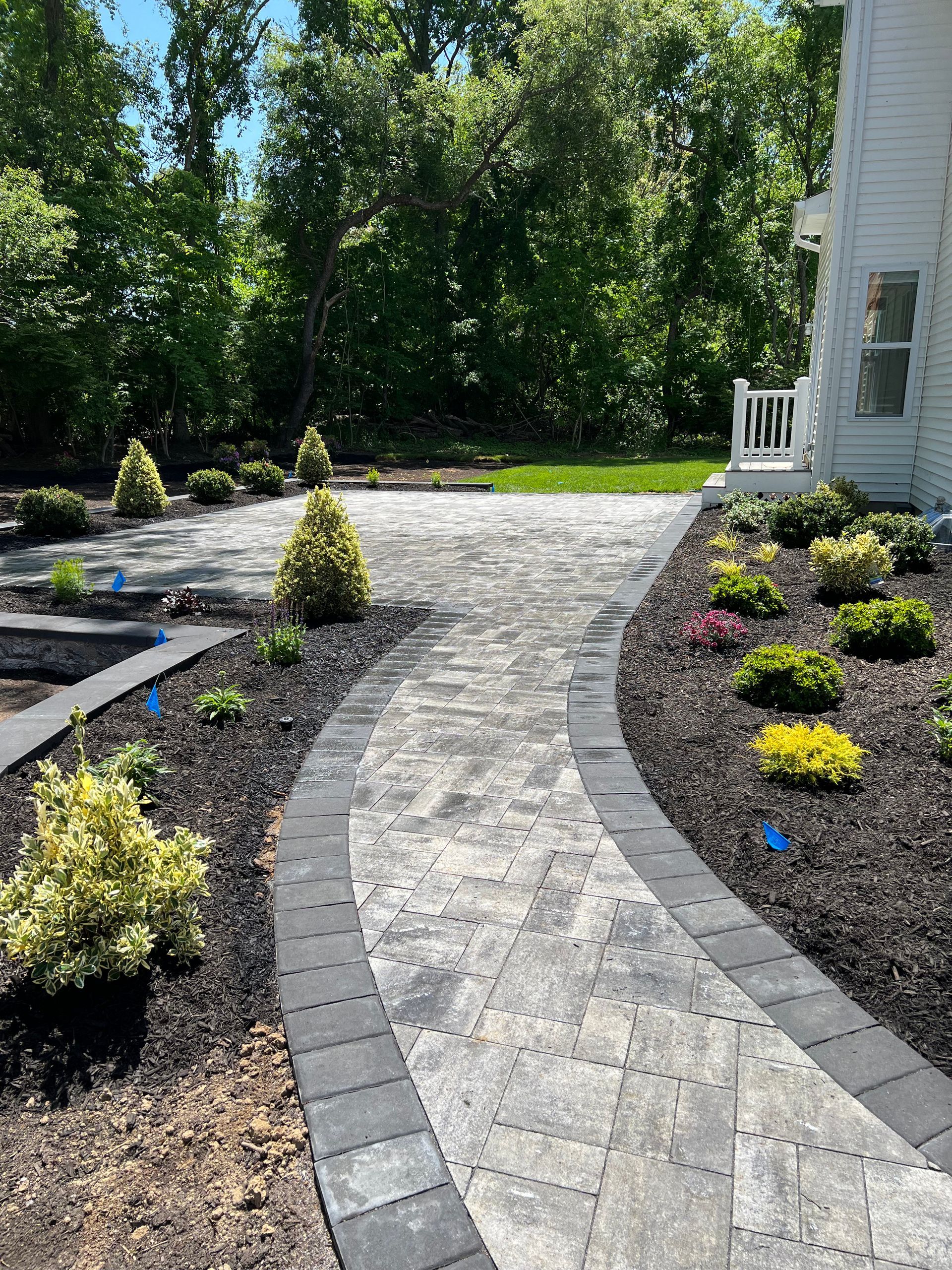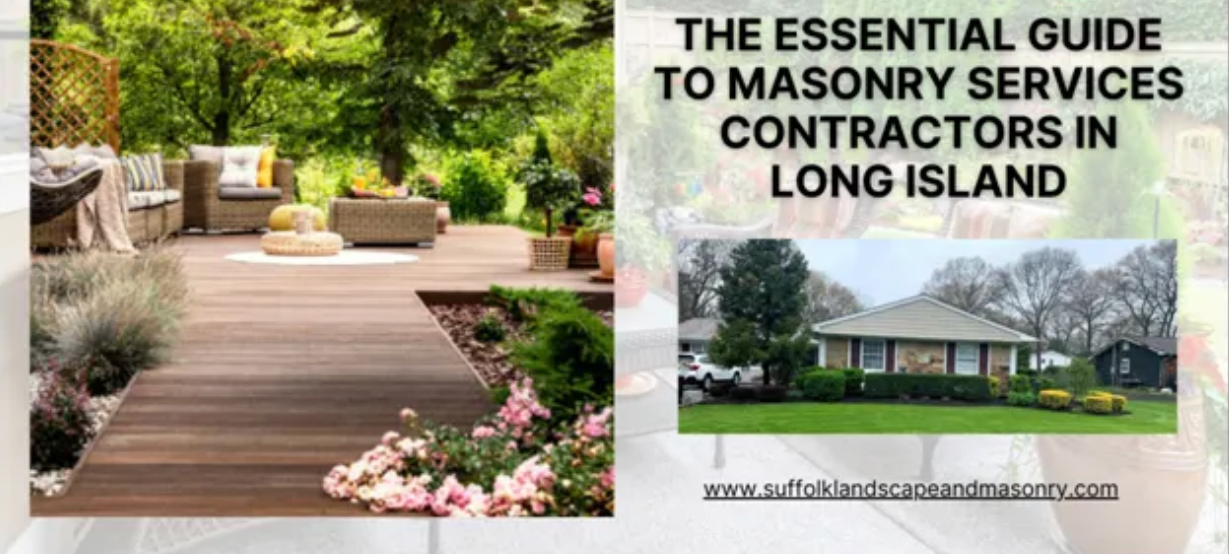How Can Landscape Lighting Transform Your Property in Suffolk County?
July 30, 2024

This blog post explores the transformative power of landscape lighting and how it can enhance the beauty and functionality of your property.
Accentuating Architectural Features
One of the most captivating aspects of landscape lighting is its ability to highlight the architectural elements of your home and surrounding structures. With carefully placed fixtures, professionals can accentuate the unique features of your property, creating a stunning visual impact.
Whether it’s illuminating the intricate details of a stone wall or casting a warm glow on a beautiful pergola, landscape lighting adds depth and dimension to your outdoor living spaces.
Enhancing Curb Appeal
First impressions matter; a well-lit property can significantly boost its curb appeal. Landscape lighting professionals in Suffolk County understand the art of illuminating pathways, driveways, and landscaping elements in a way that creates a welcoming and visually appealing entrance. This adds aesthetic value and improves safety and security for visitors and residents alike.
Creating Functional Outdoor Spaces
Outdoor living spaces have become increasingly popular, and landscape lighting is crucial in making these areas functional and inviting. Strategically placed lighting can create cozy seating areas, highlight outdoor kitchens or dining areas, and ensure safe navigation throughout your property after dark. With the right lighting design, you can transform your backyard into an extension of your living space, perfect for entertaining guests or enjoying quiet evenings outdoors.
Enhancing Landscaping Features
Your property’s landscaping reflects your style and attention to detail. Masonry Services Contractors Long Island understands the importance of showcasing these elements to their fullest potential. By illuminating trees, shrubs, water features, and garden beds, they create a captivating display highlighting the beauty of your outdoor surroundings, even after the sun has set.
Skilled Craftsmanship and Attention to Detail
Achieving the perfect Masonry Contractors Long Island design requires more than just installing fixtures. It demands a keen eye for detail, an understanding of lighting principles, and a commitment to craftsmanship. In Suffolk County, you’ll find professionals specializing in masonry services, patio construction, and more. These skilled artisans collaborate closely with homeowners to create a cohesive and visually stunning outdoor environment that seamlessly incorporates lighting into the overall design.
Final Thought
Elevating your property’s aesthetic and functionality with landscape lighting is an investment that pays dividends in both beauty and enjoyment. In Suffolk County, homeowners can access talented professionals who can transform their outdoor spaces into breathtaking havens.
Don’t settle for a bland and uninviting backyard unleash your property’s full potential by contacting the experts at Landscape Lighting in Suffolk County. Their dedication to exceptional craftsmanship and attention to detail will ensure that your home’s outdoor spaces become a source of pride and enjoyment for years.

A well-designed landscape enhances the beauty, functionality, and value of your property. Whether you’re looking to create a stunning outdoor oasis, improve your curb appeal, or maintain your lawn, professional landscape design Long Island services are essential. Landscaping By G. Pellegrino provides top-tier landscaping solutions tailored to your unique needs. The Importance of Professional Landscape Design in Long Island Investing in landscape design Long Island ensures that your property looks stunning year-round. A professionally designed landscape incorporates elements like greenery, walkways, stoops, and hardscapes to create a cohesive and aesthetically pleasing environment. Benefits of Landscape Design: Increased Property Value: A well-maintained landscape enhances curb appeal and adds value to your property. Improved Outdoor Living Spaces: Thoughtful landscaping can transform your yard into a relaxing retreat. Environmental Benefits: Proper landscaping promotes better air quality and reduces soil erosion. Seasonal Appeal: A professional landscaper will ensure your yard looks great in every season. To explore our services in landscape design Long Island, visit our website. Comprehensive Land Maintenance Services Beyond landscape design, maintaining your lawn and garden is crucial for a vibrant outdoor space. Our land maintenance services ensure that your property stays healthy and visually appealing. What Our Land Maintenance Services Include: Lawn Mowing & Edging Weed Control & Mulching Seasonal Cleanups Shrub & Hedge Trimming Irrigation System Maintenance Regular land maintenance services prevent overgrowth, improve soil health, and keep your outdoor space in pristine condition. Learn more about our maintenance solutions at Land Maintenance Services. Enhance Your Property with Stoop Construction A well-designed stoop enhances both the function and visual appeal of your home. Whether you’re building a new stoop or renovating an existing one, our stoop construction services offer durable and stylish solutions. Why Invest in Stoop Construction? Improved Accessibility: A well-built stoop provides a safe and convenient entrance to your home. Enhanced Aesthetic Appeal: Quality materials and expert craftsmanship create a stylish look. Increased Property Value: A durable and well-designed stoop adds to your home’s resale value. Explore our stoop construction services at Stoop Construction. Why Choose Landscaping By G. Pellegrino? When it comes to landscape design Long Island, land maintenance services, and stoop construction, Landscaping By G. Pellegrino stands out for its commitment to quality and customer satisfaction. Our Key Strengths: Experienced Professionals: Our team has years of expertise in landscape design and maintenance. Customized Solutions: Every project is tailored to meet your specific needs and preferences. High-Quality Materials: We use durable and sustainable materials for long-lasting results. Competitive Pricing: Our services are cost-effective, offering great value for your investment. Final Thoughts: A well-maintained landscape, durable stoops, and professional lawn care services significantly enhance your home’s overall appeal. Whether you need expert landscape design Long Island, land maintenance services, or stoop construction, Landscaping By G. Pellegrino has you covered. For more details, visit https://www.suffolklandscapeandmasonry.com/.
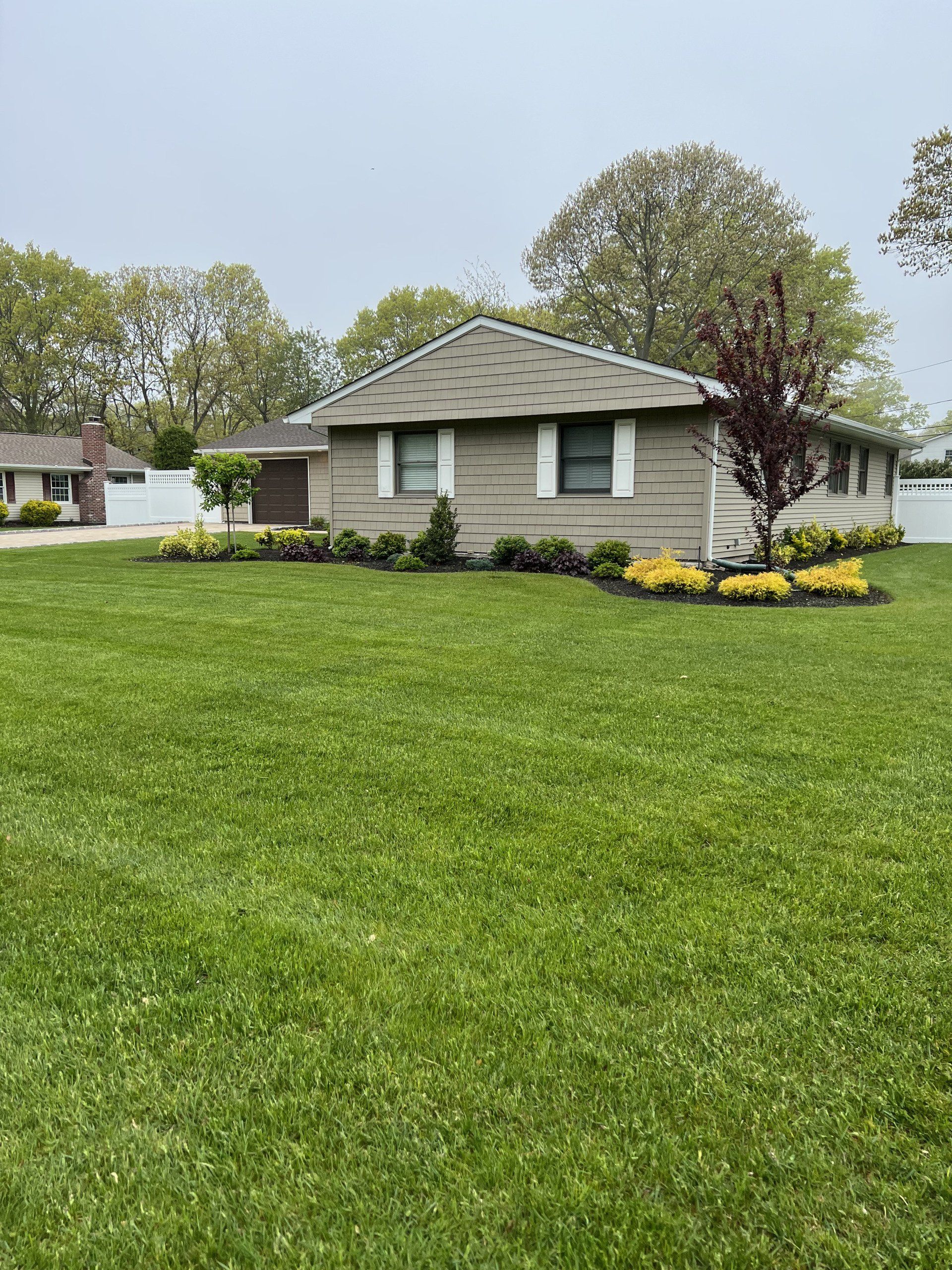
Maintaining a lush, healthy lawn requires expertise and dedication. At Landscaping By G. Pellegrino, we specialize in providing professional lawn maintenance services tailored to meet the needs of homeowners across Long Island. Whether you’re looking for routine care, custom designs, or expert masonry services, our team is here to help. Why Choose Landscaping By G. Pellegrino for Lawn Maintenance? Comprehensive Lawn Care Services Keeping your lawn vibrant and healthy goes beyond mowing. Our lawn maintenance services include: Seasonal Fertilization: Ensure your grass receives the nutrients it needs to thrive year-round. Weed and Pest Control: Protect your lawn from invasive weeds and pests. Aeration and Seeding: Promote healthy grass growth by improving soil health. Mowing and Edging: Keep your lawn looking neat and well-maintained. Learn more about our services at lawn maintenance. Expert Landscape Design for Your Home Enhance the beauty of your outdoor space with our custom landscape design on Long Island. Our team works closely with clients to create designs that complement their homes and personal preferences. From plant selection to hardscaping, we transform ordinary yards into extraordinary landscapes. For inspiration and ideas, visit landscape design Long Island. Masonry Contractors Long Island Homeowners Trust In addition to lawn and landscape services, we are also experienced masonry contractors on Long Island. Whether you need a new patio, walkway, or retaining wall, our masonry services are designed to combine functionality and aesthetic appeal. Find out more about our masonry services at masonry contractors Long Island. Benefits of Professional Lawn Maintenance Hiring experts for lawn maintenance offers several advantages: Time Savings: Save hours of labor and enjoy more free time. Improved Curb Appeal: A well-maintained lawn enhances the overall look of your property. Healthier Grass: Professional care ensures your lawn remains green and healthy. Preventative Care: Regular maintenance helps identify and address issues before they become major problems. Our team at Landscaping By G. Pellegrino understands the unique challenges of maintaining lawns on Long Island and delivers results that exceed expectations. Masonry Services to Elevate Your Outdoor Space Custom Patios and Walkways: Transform your outdoor area with custom patios and walkways designed by our expert masonry contractors on Long Island. Whether you prefer a classic or modern look, we use high-quality materials to bring your vision to life. Retaining Walls and Outdoor Kitchens: Add functionality and elegance to your yard with retaining walls and outdoor kitchens. These features not only enhance usability but also increase property value. Explore our masonry services in detail at https://www.suffolklandscapeandmasonry.com/the-essential-guide-to-masonry-services-contractors-in-long-island. The Importance of Landscape Design: Your outdoor space is an extension of your home, and investing in professional landscape design on Long Island can make all the difference. Our landscape design services include: Garden Design: Choose the perfect plants and layout for your garden. Hardscaping: Add walkways, patios, and other structures to create a balanced look. Lighting: Highlight your landscape’s best features with strategically placed lighting. Schedule Your Lawn Maintenance Today Don’t let lawn care become a burden. Trust Landscaping By G. Pellegrino to keep your yard looking its best. From routine lawn maintenance to custom landscape design on Long Island, we’re here to help. Visit us to learn more about our services or to schedule an appointment. Why Landscaping By G. Pellegrino Stands Out Experienced Professionals: With years of experience, our team delivers exceptional results. Customized Solutions: We tailor our services to meet your specific needs. Affordable Pricing: Enjoy high-quality services at competitive rates. Customer Satisfaction: Our priority is your happiness and satisfaction. Whether you’re looking for reliable lawn maintenance, expert masonry contractors on Long Island, or stunning landscape design, we’ve got you covered. Contact us today and see the difference professional care can make for your property.
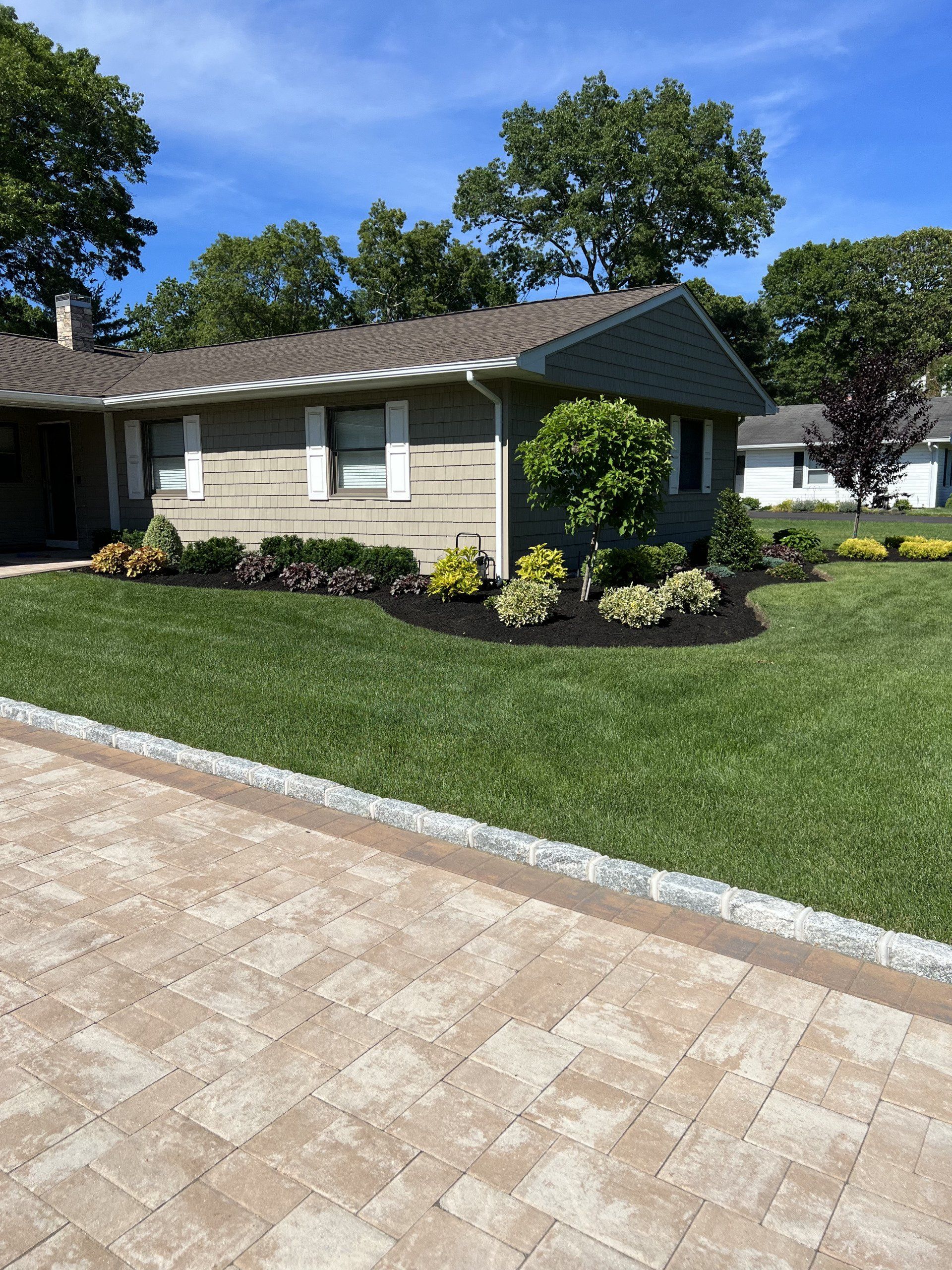
In today's fast-paced atmosphere, homeowners usually find themselves working to preserve a gorgeous lawn. Requiring job plans, family duties, and social activities may limit time for lawn upkeep. Low-maintenance landscaping is the perfect solution as it looks attractive with little work. Using the correct materials and strategic design concepts can allow you to create a rich and appealing yard that requires less care. Why Low-Maintenance Landscaping Matters In addition to saving time, a well-considered, low-maintenance landscape lowers water use, lowers prices, and diminishes environmental effects. Efficient watering systems and drought-resistant plants help you to save resources while keeping a vivid yard. Moreover, a simpler design lowers the need for regular weeding, trimming, and mowing, making it ideal for households or people who want to enjoy their outdoor area free from the weight of continuous upkeep. Choosing the Right Plants for Easy Care Any low-maintenance landscape's foundation is choosing the appropriate plants. Native plants are a wonderful option because of their natural adaptability to the local temperature and soil; they also need less water and maintenance. With little care, perennials, drought-tolerant succulents, and decorative grass may offer your landscape texture and colour. Avoid high-maintenance plants that require frequent trimming or are susceptible to pests. Hardscaping for Durability and Elegance Pathways, patios, and stone accents among other hardscape components may greatly improve a landscape's look and lower care requirements. Unlike grass, materials like natural stone, pavers, or gravel need minimal maintenance and are lasting. Apart from providing a useful outdoor living area, a well-designed patio or deck helps to minimize the area needing watering or mowing. Including a sitting area or fire pit can improve the useability of your yard even further. Mulching: A Simple Way to Save Time One cheap and handy tool for cutting garden upkeep is mulch. Mulching around plants helps one to control weeds, preserve soil moisture, and maintain temperature; so, it lessens the need for watering and weeding. Organic mulches, including wood chips or bark, break down over time to enrich the soil and encourage more lucrative growth. This one operation will save many hours of care and keep your garden looking flawless. Using Smart Plant Grouping for Efficiency Hydrozoning, or strategic plant grouping, is the arrangement of plants with similar water and sunshine requirements. This method guarantees effective irrigation and helps to lower underwatering or overwatering. Clustering drought-tolerant plants in sunny locations, for example, while keeping shaded places for moisture-loving plants produces an environment wherein each group flourishes with little intervention. Correct plant spacing also facilitates air circulation, therefore lowering the danger of pests and diseases and hence less care generally. Benefits of Decorative Gravel and Rock Gardens • Weed Control: Gravel and rocks naturally block weeds from invading your space. • Water Conservation: Arid areas would find these characteristics perfect because they reduce water use. • Durability: Unlike organic materials, they keep their look throughout time and resist breakdown. • Low Maintenance: They are easily cleaned and there is no need for pruning or mowing. Incorporating Low-Maintenance Lawn Alternatives High-maintenance traditional lawns need for frequent mowing, watering, and fertilizer. Ground coverings like clover, creeping thyme, or moss provide rich vegetation without the care required of grass. Another choice with no work and a neat, groomed appearance all year long is artificial grass. Reducing the area of the lawn and substituting wildflower meadows or beautiful gravel for portions can provide a visually dynamic and sustainable environment for people looking for a mix. Adding Functional and Aesthetic Features Low-maintenance yards would benefit much from raised plant beds, water features, and garden art. Designed correctly, a tiny fountain or pond creates a peaceful environment and requires little maintenance. Raised beds featuring food plants like herbs or veggies may help to lessen the need for bending while still allowing access and use. Including creative accents like trellies, sculptures, or beautiful pots guarantees that your yard stays aesthetically appealing with less maintenance. Combining these elements will help your landscape to be both aesthetically pleasing and useful, and fit for a hectic existence. Efficient Irrigation for Water-Wise Landscapes A well-installed, effective watering system is what makes a low-maintenance yard. Drip irrigation systems ensure your plants get the moisture they need and help to avoid waste by delivering water directly to the roots. By changing water schedules depending on the weather, smart irrigation controllers may save time and money. These solutions minimise the need for hand watering and guarantee the condition of your landscape even in your absence. Conclusion A low-maintenance landscape design is the best solution for busy individuals seeking a beautiful, practical outdoor environment free of continuous upkeep. A careful selection of plants, efficient irrigation systems, and strong hardscaping elements taken together will enable you to create a yard that is low-maintenance and gorgeous. Landscaping by G. Pellegrino specializes in designing custom plans that mix visual appeal with utility. Simplify your outdoor living experience and appreciate a scene that naturally accentuates the worth and beauty of your house.
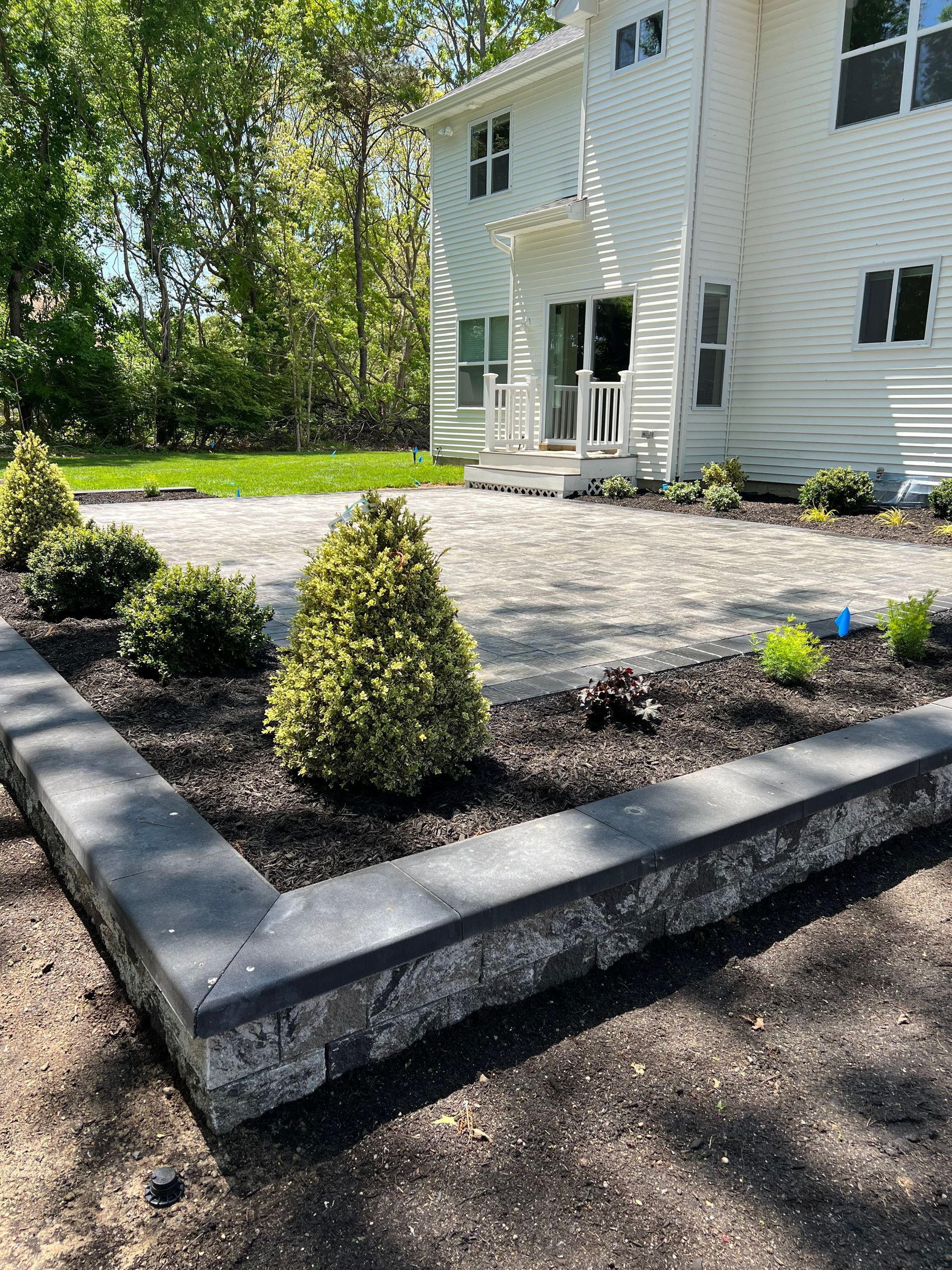
Changing your outside area not only improves the look of your house but also raises its worth and useability. Landscape design has developed recently from simple garden beautifying to include new technologies, sustainability, and personalizing features. Whether your goal is to redesign your backyard or simply get some design inspiration completely, this blog will walk you through the best landscaping ideas transforming houses all over. Embracing Modern Landscaping Ideas Modern landscaping ideas are leading the front in a change of outdoor areas. Focusing on simplicity and clear lines, these ideas combine sleek, modern aesthetics with useful functionality. Using geometric patterns in the pavement is a common trend that not only brings some modernism but also guides movement inside the garden. Including contemporary materials like weather-resistant composites or polished concrete can revitalize any outside space. The Rise of Modern Materials in Landscaping Incorporating modern materials such as weather-resistant composites, polished concrete, and even industrial metal accents can change a traditional garden into a modern masterpiece. These materials not only offer durability and comfort of care but also add a smart, simple aesthetic that is becoming increasingly popular among homeowners looking for a modern touch in their outdoor spaces. Sustainable Landscaping Trends As more homes want to lessen their environmental impact, sustainable landscaping trends are gathering steam. These methods focus on designing environmentally friendly areas with less upkeep and resources needed. Important components include rainwater collecting devices, solar-powered lighting, and native plants that flourish under local circumstances without additional fertilizers or irrigation; adopting sustainable landscaping designs guarantees a green area that stays vivid all year long in addition to benefiting the surroundings. Techniques for Eco-friendly Landscaping A garden can be even more sustainable by learning more about sustainable gardening techniques and using plants that can survive in dry conditions. These ways cut down on the need for chemical and water solutions, which makes the local environment healthy. Sustainable gardening also often includes making places for animals to live, which increases variety and gives helpful bugs and birds a place to live. Discover Backyard Design Inspiration • Outdoor Living Rooms: Create an outdoor living room out of comfy chairs and weather-proof décor to expand your living area. • Edible Gardens: Plant edible herbs and veggies that provide fresh food while adding color and texture to your environment, therefore combining utility and flair. • Water Features: Little ponds or fountains will help to create a relaxing atmosphere and attract animals. • Fire Pits and Seating Areas: Perfect for hosting events, a fire pit surrounded by comfortable chairs may take the front stage in your backyard. Expanding Outdoor Functionalities Beyond simple relaxation, integrating functional features such as outdoor kitchens and fitness areas can maximize the usability of your space. Outdoor kitchens offer a great way to entertain guests with al fresco cooking and dining, while dedicated fitness zones promote a healthy lifestyle, blending well-being with outdoor enjoyment. Tips for Landscape Renovation Landscape renovation tips will enable you to improve your outside area quickly. First, evaluate your present scene and note areas needing improvement. For significant alterations, including landscape modification or permanent feature installation, think about seeing an expert. Plan your improvements also around the seasons; for example, plant new trees and shrubs in the dormant season to guarantee they grow roots by spring. Strategic Planning for Landscape Redesign A planned approach to makeover includes both improvements to how things look and improvements to how they work. To make your yard look better and work better, think about how people will move through it, how much shade and sunlight there is, and how you can use new technologies like automatic watering systems. Incorporating Outdoor Space Transformation There needs to be more than just a few flowers in the outdoor room makeover area. Careful design and planning make a place that works well and feels like a whole. The way people landscape these days includes outdoor kitchens, eating rooms, and even gyms. These parts create a room that can be used for different things and add living space outside of your home. Changing the way your outdoor space transformation can help you make an environment that works for your lifestyle, whether that means planning events, eating with family, or relaxing in a quiet spot. Conclusion Landscape design has the transforming ability to make any outside space a beloved extension of your house. It's all about designing places that support sustainability and usability while nevertheless reflecting personal tastes. Landscaping By G. Pellegrino provides the knowledge required to make sure your outside area realizes its potential, whether you're ready to start your landscape change or want particular advice catered to your location. Emphasizing contemporary and environmentally friendly designs, they enable every garden not only to flourish but also to convey its narrative.

Essential elements in many contemporary gardens and retaining walls have both practical and decorative value. A well-designed retaining wall may change the area, whether your garden rests on uneven ground or you want to improve the layout and beauty. These buildings define planting areas, paths, or sitting areas, adding esthetic appeal while also helping to minimize soil erosion and water drainage. This blog discusses the many advantages of building landscaping retaining walls in your garden, as well as why they may be an ideal complement to your outdoor area. What are Retaining Walls? A retaining wall, especially in gardens with hills or uneven ground, serves as a structural element to prevent soil from sliding or eroding. These walls let homeowners pick materials that fit the style of their garden, like stone, concrete, brick, or wood. Despite their primary utility, homeowners can exquisitely incorporate retaining walls into the overall landscape to create terraces, flower gardens, and level paths. Beyond their capacity to hold soil, these walls sometimes take the front stage in landscape plans as they combine utility with elegance. The Role of Retaining Walls in Erosion Control Retaining walls operate mostly as a means of controlling soil erosion. Gardens located on slopes or uneven ground are particularly prone to erosion, especially after heavy rain. Water running downhill could wash away the soil, resulting in instability and nutrient loss. Retaining walls stabilize the slope, slow down soil movement, and manage water runoff, thereby helping guarantee that your plants stay safe and healthy in their natural locations, as well as shield your garden from erosion. Retaining walls might be a long-lasting fix for safeguarding the integrity of your landscape, depending on the correct installation. Versatility in Garden Design Retaining walls provide many opportunities for artistic garden design. They allow you to create multiple levels in your landscape, giving sloping or level areas character and depth. Retaining walls allow you to create distinct sections for a variety of plants, vegetable gardens, or even patios, which are enjoyable places. As follows: • To simplify planting on sloping ground, build terraced gardens with retaining walls. • Create elevated flower gardens that highlight specific shrubs or plants. • Along the retaining wall, design seating sections with beauty and utility. • Build paths and stairs to navigate many levels of your garden. These innovative ideas will make your outdoor space more useful and inviting for leisure and pleasure. Enhancing Drainage and Water Management Retaining walls is critical for improving water flow in your garden. Particularly in gardens with uneven ground, poor water management may result in floods, stagnant water, and damage to plants. Retaining walls correctly planned may control water flow and stop collecting in undesired locations. By installing drainage pipes behind or within the retaining walls, you help to redirect water away from your garden. This ensures a better garden because it reduces the risk of soil erosion and prevents overwatering of plants. Good drainage also protects your house's foundation, as retaining walls stop water from collecting up close by. Increasing Property Value Retaining walls incorporated into landscaping can greatly increase your house's value. Buyers usually find homes with well-kept exterior areas more attractive; hence, retaining wall construction may be crucial in improving curb appeal. Retaining walls provide your garden with structure, order, and beauty, increasing its appeal to potential buyers. Furthermore, for homeowners looking for a low-maintenance landscape, these elements might be appealing since they provide useful advantages such as better drainage and erosion prevention. Investing in premium landscaping with retaining walls might pay off if you want to sell your house sometime. Customization Options for Every Style Retaining walls offer numerous advantages due to their versatility in materials and design, allowing you to customize them to match the aesthetic of your landscape. There are many choices to investigate, whether your taste is contemporary with concrete or natural with stone walls. Depending on the general concept of their garden, homeowners may pick from a wonderful variety of materials like natural stone, bricks, concrete blocks, or even wood. In terms of durability, look, and maintenance, each substance has special benefits. Customizing the size, form, and materials of retaining walls guarantees their perfect fit into the current terrain. Low Maintenance Requirements After construction, retaining walls often require relatively little maintenance. Although these buildings are generally intended to last, depending on the material used, you may need to perform sporadic cleaning or fix tiny fractures. Stone and concrete walls are particularly strong and often last decades without requiring major repairs. Wooden retaining walls require more maintenance to prevent decay, but you can treat them to extend their lifespan. Because of their minimal maintenance character, retaining walls are an excellent alternative for homeowners looking for long-term landscaping solutions free of continuous maintenance. Creating Usable Space in Sloped Gardens If the slope is steep, using the space in your yard might be difficult. Retaining walls level out regions and increase their functionality, thereby providing a solution. Building terraces with retaining walls will provide level ground perfect for play spaces, dining, or gardening. This is very helpful for homeowners with sloping or mountainous yards who want to maximize the usable area. Retaining walls can turn a once-unusable area of your yard into a lovely and useful space that presents opportunities for fresh landscaping ideas that are otherwise unfeasible on uneven terrain. Long-Term Durability and Investment Retaining wall investments will benefit your property over time. We design these constructions to withstand environmental stresses such as harsh weather, water erosion, and soil movement. Retaining walls provide a long-lasting solution, unlike transitory landscaping elements, when constructed with premium materials and the correct installation will endure decades. For homeowners who want to have a long-lasting effect on their outside area, retaining walls are a smart investment because of their lifetime. Retaining walls may provide lifetime beauty and utility by selecting appropriate materials and guaranteeing skilled installation, thereby reducing the need for regular repairs or replacements. Key Advantages of Landscaping Retaining Walls • Erosion Control: Retaining walls stabilize slopes and control water flow, thereby stopping soil erosion. • Aesthetic Appeal: These walls give your grounds more deep and structure, permitting you to come up with creative landscaping ideas. • Improved Drainage: Appropriately planned retaining walls help to control water management, therefore reducing water buildup and floods. • Increased Property Value: Well-made retaining walls may improve curb appeal and raise your house's overall value. These advantages make retaining walls a must-have for homeowners trying to enhance the appearance and usefulness of their garden areas. Conclusion From stopping soil erosion to improving the general visual appeal, retaining walls provide several benefits for your garden. For many landscaping problems, they are a sensible answer, as they may create useful areas on sloping terrain and enhance drainage. Trust Landscaping By G. Pellegrino to realize your idea for a professional and sturdy retaining wall installation. With the proper design and materials, retaining walls greatly improves the appearance and use of your outdoor area.
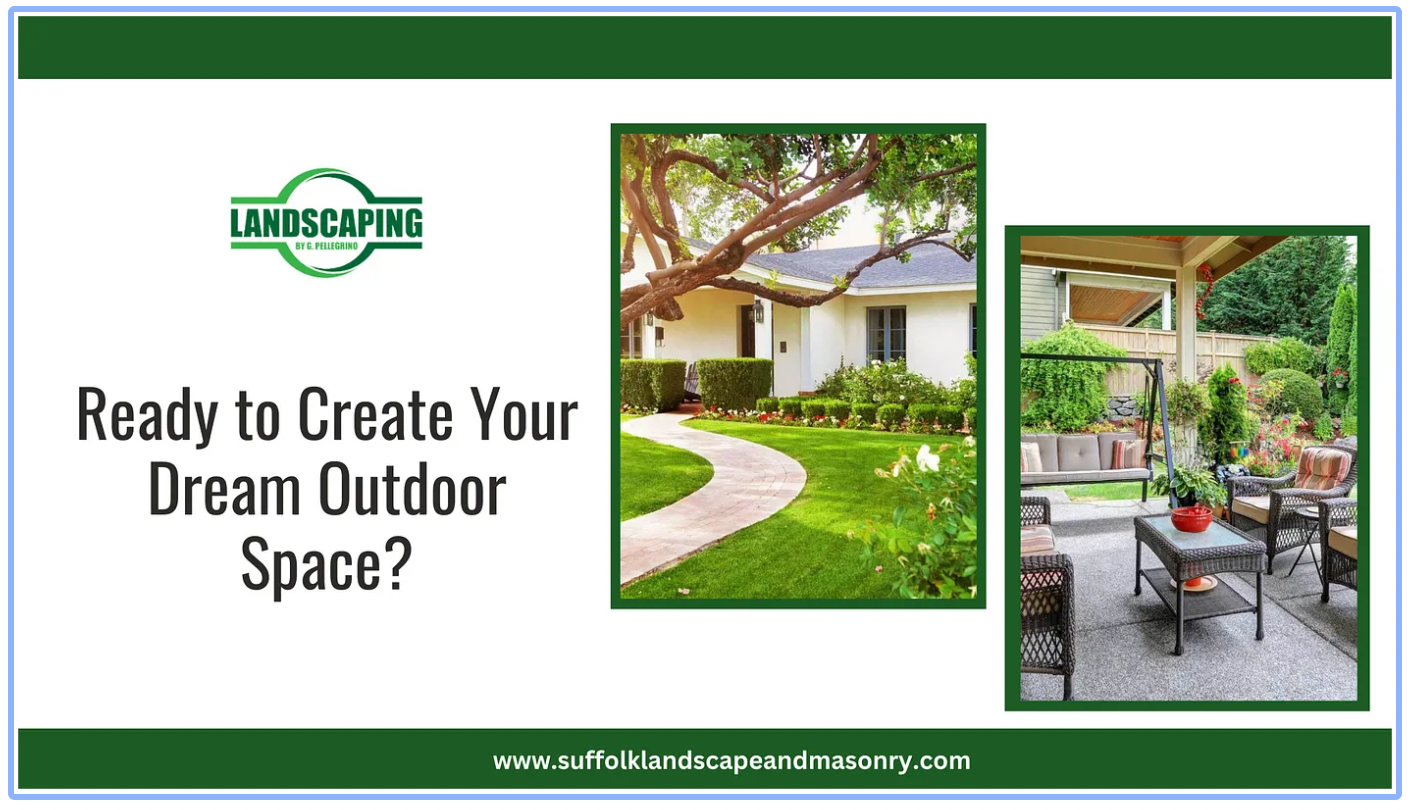
Are you dreaming of transforming your outdoor space into a beautiful, inviting oasis? Well, get ready to turn your dream into reality because when it comes to Patio Construction Contractor Long Island, you’re in for a treat! Have you ever wondered, Where can find top-notch Landscape Design Services Long Island? or How to I create the perfect outdoor space with Landscaping Retaining Wall Services Long Island? In this blog post, we’ll dive into the world of outdoor living and introduce you to experts who can make your outdoor space the envy of the neighborhood. Let’s explore the world of outdoor design with positivity and enthusiasm! Is Patio Construction Contractor Long Island the Key to Your Perfect Patio? Your outdoor space is an extension of your home and should be a place to relax, entertain, and connect with nature. If you’re considering Patio Construction Contractor Long Island, you’re on the right path to creating the outdoor haven you’ve always wanted. Why Choose Us? Unlock the Benefits of Professional Patio Construction Expertise: Patio Construction Contractor Long Island brings you a team of skilled professionals who design and build stunning outdoor patios. They understand the latest trends and techniques to create the perfect outdoor space. Enhanced Beauty: A well-designed patio can significantly improve the beauty of your outdoor area. Whether you are looking for Paving Stone Patios in Suffolk County or Walkways in Suffolk County, these experts can make your vision come to life. Increased Property Value: A beautifully constructed patio not only adds to your outdoor enjoyment but also increases the overall value of your property. The Magic of Landscape Design Creating the Perfect Outdoor Ambiance with Landscape Design Services Long Island Personalized Design: Landscape Design Services Long Island offers customized design solutions tailored to your preferences and the unique features of your outdoor space. Plant Selection: Professionals in landscape design understand the importance of selecting the right plants and trees that thrive in Long Island’s climate, ensuring a vibrant and healthy outdoor environment. Quality Landscaping Retaining Walls Why Choose Landscaping Retaining Wall Services Long Island? Erosion Control: Landscaping Retaining Wall Services Long Island is an expert in preventing soil erosion and creating terraced landscapes, adding beauty and functionality to your outdoor space. Versatility: Retaining walls can define areas, create seating, and add structural support to your landscape design. Elevate Your Outdoor Living Experience Conclusion Your outdoor space has the potential to be a stunning and functional extension of your home. Whether you’re interested in Patio Construction Contractor Long Island, Landscape Design Services Long Island, Landscaping Retaining Wall Services Long Island, Paving Stone Patios in Suffolk County, or Walkways in Suffolk County, you’re on the path to creating the outdoor paradise you’ve always wanted. Ready to transform your outdoor space into a breathtaking oasis? Contact us today for top-quality Patio Construction, Landscape Design, and Landscaping Retaining Walls services. Your outdoor space will thank you for it, and you’ll enjoy the beauty and serenity of your perfectly designed outdoor haven!
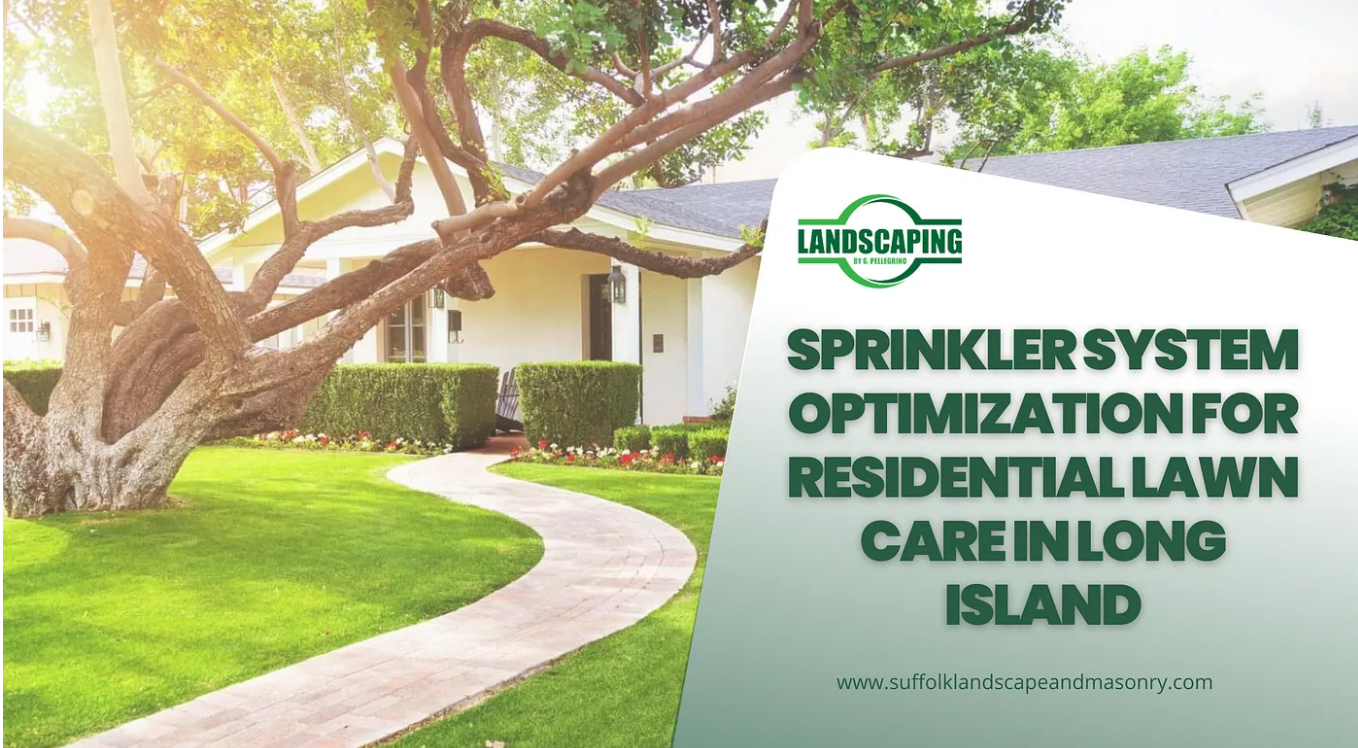
Living in the picturesque region of Long Island, it becomes essential to maintain the aesthetics of your residential property. One significant aspect of this is efficient residential lawn care maintenance. While numerous methods can ensure a lush green lawn, one crucial component is an optimally functioning sprinkler system. We’re gonna talk about how to optimize sprinkler systems for efficient lawn care in Long Island. Sprinklers- What do you need to know? Firstly, it is crucial to understand how your sprinkler system functions. Organized into different zones, it delivers water to your lawn at set intervals. To maintain your sprinkler system efficiently, ensure that each section operates correctly, there are no leaks, and the sprinkler heads are clean and appropriately aimed. As part of leading residential lawn services in Long Island, we advise an annual check-up of your sprinkler system to ensure it functions smoothly. Best Way to Adjust Sprinklers for Optimal Coverage The most common issue homeowners face with sprinkler systems is the uneven distribution of water, leading to poor lawn health. To ensure that the system covers all lawn areas, adjust the sprinkler heads correctly. There should be an overlapping pattern, and each area of the lawn should receive water from two sprinkler heads minimum. Following these simple steps will ensure excellent coverage and foster healthy grass growth. Programming the Sprinkler System The programming of your sprinkler system is also fundamental to achieving efficient lawn care. The watering frequency should go hand in hand with the lawn’s requirements and climatic conditions. The soil type, grass species, and overall lawn health are vital in determining the watering schedule. As masonry contractors in Long Island with extensive experience in landscaping, we recommend watering your lawn early in the morning when the evaporation rate is relatively low. Regular Maintenance and Inspection Ensure routine checkups of your sprinkler system, looking for potential leaks, faulty valves, or blocked sprinkler heads. Remember to adjust the watering schedules with seasonal changes. The amount of water your lawn needs in mid-July will be different compared to early Spring. What is the Role of Professionals? While the aforementioned tips will help you maintain an efficient sprinkler system, professional assistance can further optimize the process. Experts from masonry services contractors in Long Island, like our company, can perform a thorough examination, helping you prevent future issues and save water — and by extension, save money. Investing in Smart Sprinkler Controllers Smart sprinkler controllers have become increasingly popular due to their efficiency and convenience. These devices monitor weather conditions, soil moisture, and other factors to automatically adjust the watering schedule accordingly.Investing in this technology can lead to substantial water and cost savings, as your sprinkler system only delivers water when necessary. Moreover, with most smart controllers offering smartphone app integration, you have more control over your sprinkler system, even when you’re away from home. Promoting Water Conservation Efficient residential lawn care maintenance doesn’t just have aesthetic benefits, it also promotes water conservation. By optimizing your sprinkler system, you actively reduce water waste. This not only saves money on your water bill but also contributes to eco-conscious lawn care practices. Implementing rain sensors, which automatically turn off the sprinklers when it’s raining, or a drip irrigation system for flower beds and shrubs, can significantly minimize water waste and contribute to a sustainable environment. Customizing Lawn Care for Your Property Understanding that each lawn is unique is crucial for optimizing your sprinkler system and ensuring efficient lawn care. The soil type, grass species, and landscape features all play a role in determining how much water your lawn needs and the optimal watering frequency. For instance, lawns with sandy soils require more frequent watering than clay soil ones. Additionally, shadowed areas might need less water as they lose less moisture due to evaporation. Customizing your sprinkler system to cater to such specific needs will result in better water management and a healthier lawn. Wrapping Up Optimizing your sprinkler system goes a long way in ensuring a well-maintained and healthy lawn. It may seem overwhelming initially, but with the correct methods, it becomes effortless. Regular maintenance and periodic professional assistance can ensure peak performance from your sprinkler system. We hope this guide helps you enhance lawn health through efficient water utilization. Remember, the key to a beautiful lawn lies as much in good watering practices as it does in regular mowing and fertilization. If you are looking for professionals who specialize in residential lawn care maintenance in Long Island, do not hesitate to contact us. Our team can provide top-tier, efficient, and sustainable lawn services that cater to your lawn’s unique needs.

